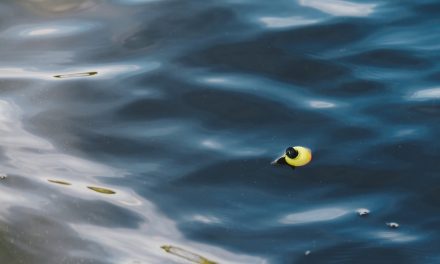You never realize how vital a bilge pump is until you really need one. A little water in the bilge is one thing, but when you open that hatch and see a dangerously flooded compartment, you’ll be thankful you have equipment designed to keep you afloat.
Safety precautions on a boat are necessary, and having the right bilge pump is critical. So, if you’re looking for the best bilge pumps available and advice to help you decide which pump is best suited for your needs, we’re here to help.
What is a bilge pump used for?
A bilge pump is used to remove water that’s leaked into the lower interior compartments of a boat.
Is a bilge pump necessary?
Having a bilge pump on a boat is a matter of safety and is absolutely necessary.
Without one, compartments within the boat could fill with water, and there would be no way to remove it effectively. If enough water builds up in these compartments, it can critically affect the ability to pilot the boat and, in worst-case scenarios, cause the boat to sink.
Owning a bilge pump is the most efficient precaution a boater can take to protect themselves and their boat in preparation for these dangerous situations.
BEST AUTOMATIC CENTRIFUGAL BILGE PUMP: MAXZONE Automatic 1100 Submersible Bilge Pump
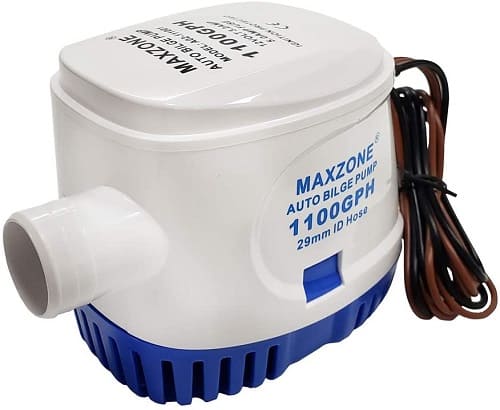
This Maxzone bilge pump features a built-in float switch with a reed sensor system that monitors the bilge’s water level. Once the water reaches a certain level, the internal float switch turns the pump on automatically. After removing water, the pump shuts itself down.
Thanks to the fact it only turns on when necessary and for no longer than is truly needed, the pump is very energy efficient. It only draws 3.8 amps from the battery when it’s running and doesn’t use any power when it’s not pumping water. Although this self-monitoring system is very convenient and generally reliable, there’s more chance of being caught off guard by malfunction than non-automatic pumps.
This model pumps out 1100 gallons per hour, which is not the highest output on our list but will more than handle the average boater’s needs.
Like many automatic bilge pumps, the Maxzone does not come with a manual on/off switch. If you don’t want to rely on the built-in float switch and enjoy the option to run the pump water whenever you think it’s necessary, you’ll need to purchase one separately.
pros
- Energy efficient 3.8 amp draw
- 1100 gallons per hour
- Built-in float switch pumps automatically
cons
- Does not come with a manual on/off switch
- Risk of automatic pumping sensors malfunctioning
BEST NON-AUTOMATIC CENTRIFUGAL BILGE PUMP: Rule Marine 2000 Bilge Pump

Rule Marine has been in business for over 50 years and is one of the most widely trusted manufacturers of bilge pumps around. They produce pumps that meet commercial standards and are renowned for their reliability and longevity.
Pumping out an impressive 2000 gallons per hour, it has the highest capability of all the options on our list. Consider this degree of power it’s a surprisingly quiet unit.
This pumping power, however, is delivered at the cost of energy efficiency. The 12-volt model draws 8.4 amps, making it the pump with the highest power usage on our list.
The appeal of a non-automatic pump like this is reliability. You do not depend on an internal float switch and automatic sensor functioning properly to start the pumping process. You simply flip a switch, and it starts up. It requires you to keep on top of the levels, but for the boater who’d rather depend on themselves than an automatic system, it’s a preferable setup.
The biggest drawback of this unit is the price. Though the quality may be worth the price, it’s still worth noting that it’s the most expensive pump on our list.
pros
- 2000 GPH
- Manufactured to commercial standards
- Quiet
- Manual on/off switch is more reliable than auto float switch
cons
- Expensive
- Draws 8.4 amps
BEST DIAPHRAGM BILGE PUMP: Amarine Made 12v Water Pressure Diaphragm Pump
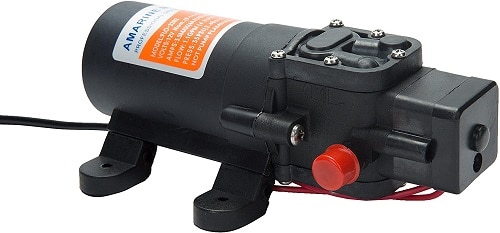
This diaphragm pump meets some unique needs that the automatic and non-automatic centrifugal pumps on this list do not. It is self-priming and can be run dry for an extended time without damaging the pump. This feature allows the bilge to empty completely, whereas centrifugal pumps will typically leave some water behind.
The Amarine pump creates suction, allowing water to travel vertically with more efficiency, which is ideal for boaters who need water lifted up and out of a relatively tall bilge.
This pump’s energy draw is a low 2.7 amps, although its pumping capacity is only 66 gallons per hour, well below a centrifugal unit’s capabilities. So, not only will it take longer for the water to empty, the energy draw will be sustained over a longer time.
The pump is well made with quality materials and tested in the factory before shipping to ensure each unit functions correctly. However, something to keep in mind is that diaphragm pumps are more likely to jam due to small debris in the water than centrifugal pumps.
pros
- Lifts water efficiently out of tall bilges
- Can be run dry without any causing damage
- Energy efficient 2.7 amp draw
cons
- Slow pump rate compared to centrifugal pumps
- Prone to jamming
BEST BUDGET PICK: MAXZONE Non-automatic 1100 Bilge Pump
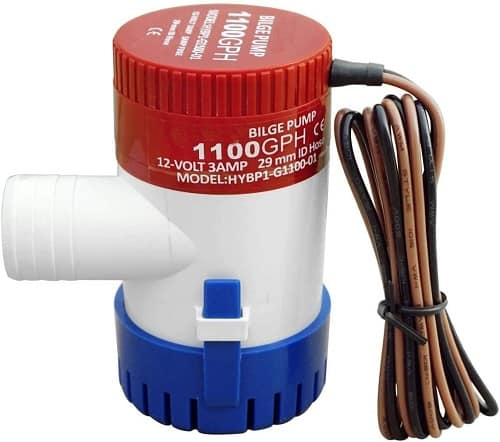
If you’re looking for a budget-friendly bilge pump, the non-automatic model of the Maxzone 1100 is a great option.
Considering the price point, this is a reasonably durable and reliable unit. The shaft for the motor is stainless steel, and the housing is impact-resistant plastic. Although this pump is well constructed, it still may not last as long as some high-end units. That said, it’s significantly cheaper and comes with a lifetime warranty.
Similar to the Maxzone automatic pump, this non-automatic model has a respectable pumping capacity of 1100 gallons per hour which is suitable for most boaters. It also has a low power output of 3 amps, making it one of the more energy-efficient pumps on our list.
Even though you could easily use this unit as your primary bilge pump, it also could serve as an inexpensive backup pump. It’s pretty common to see people using an automatic model as their primary pump and a non-automatic as a secondary backup. The reliability of a non-automatic design combined with this unit’s low cost makes it ideal for this type of pump system.
pros
- Budget-friendly
- Durable and reliable considering the price point
- Great backup pump option
- Lifetime warranty
cons
- May not last as long as high-end pumps
BEST MANUAL BILGE PUMP: SeaSense Hand Bilge Pump
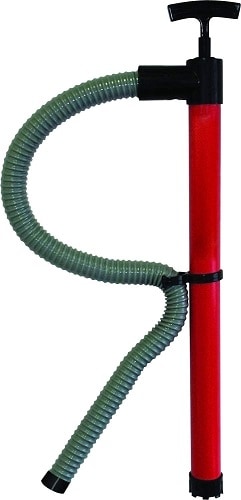
You should always hope for the best but plan for the worst, and purchasing a manual bilge pump like this one from SeaSense is a worthwhile precaution.
Even the most reliable and heavy-duty pump on this list won’t help you if the boat’s electrical system goes out. To prepare yourself for this situation, you need a way to pump out water that doesn’t rely on electricity. This hand pump is the perfect backup plan. It may take you longer and require more physical effort than an electric pump, but at least you’ll be able to pump out the water.
This unit is lightweight and requires no installation, making it the most portable pump on our list. This makes it easy to switch between boats or lend to a fellow boater who’s having trouble with their bilge pump.
Aside from bilge water, this pump could come in useful if you need to remove built-up water from a compartment where you’d never install a bilge pump. It’s also inexpensive, so even if you never use it, it at least provides some low-cost peace of mind.
pros
- Backup pump if electricity is out
- Lightweight and portable
- Inexpensive
cons
- Requires physical effort to pump water
- Very slow flow rate
Types of bilge pumps:
Automatic and non-automatic centrifugal
Centrifugal pumps come in automatic and non-automatic models but pump water using the same mechanical design. The pump runs electrically and uses a motorized propeller that rotates and forces water from the compartment and through a hose.
They must be submerged in water to function correctly and should not be left to run dry for any length of time. Compared with diaphragm and manual pumps, centrifugal pumps can pump the highest quantity of water in the shortest amount of time.
The mechanism that turns the pump on and off is the main difference between an automatic and non-automatic centrifugal.
AUTOMATIC
Automatic centrifugal pumps either have a built-in sensor and float trigger that turns the pump on once the bilge’s water level has reached a specific level, or they run on a timed cycle turning on at particular intervals and running for a set time.
In both cases, the pump is turned on and off without any effort. Although you can rig them with a manually operated on/off switch, these pumps’ primary purpose is to provide convenience for people who prefer not to monitor the water level in the bilge continuously and actively operate the pump.
NON-AUTOMATIC
Non-automatic centrifugal pumps have no built-in sensors or triggers, they’re simply wired to an on/off switch. This requires the boater to monitor the water level in the bilge actively and turn the pump on manually.
Although they can be rigged with a float switch to provide the same conveniences as an automatic centrifugal pump, this pump’s primary purpose is to give people the ability to turn the pump on and off at their discretion.
Diaphragm
Diaphragm pumps are operated electrically and consist of chambers and valves that create suction, pulling water out of the bilge through the valve/chamber system and pumping a pressurized stream of water out a hose. They are self-priming and, unlike centrifugal pumps, can be run completely dry without the risk of damage. They also do not need to be submerged to pump water.
One downside of these pumps is that they’re more likely to jam and malfunction than centrifugal units. This is because the water flows directly through the chamber and valve system, creating the potential for debris to build up and jam the valves.
Diaphragms cannot pump water at the same speed and quantity as a centrifugal pump. Boaters who prefer these types of pumps value their ability to pump water vertically out of tall bilges. They also like that they can completely dry a bilge as opposed to centrifugal pumps that typically leave a low level of water behind.
Manual
Manual pumps, also referred to as hand pumps, operate based on the physical effort of the user and, unlike centrifugal and diaphragm pumps, have no electrical or motorized components.
The pump utilizes a lever or handle that must be physically moved up and down to create suction within the primary pump chamber. With each up and down motion, the water is sucked from the bilge and expelled out through the chamber.
The pumping capacity of a manual pump is minimal and requires extended physical effort to function. Unless you are using a kayak or very small boat, a manual will likely be a backup pump if the primary pump fails or the boat’s electrical system is down.
What to look for in a bilge pump:
Gallons per hour (GPH)
The GPH, or gallons per hour, refers to the quantity of water a unit can pump each hour. This number helps set a baseline statistic to compare the pumping power of each unit.
Centrifugal pumps have the highest rate ranging between 500-4000 GPH. Diaphragms, on the other hand, have significantly lower rates of under 100 GPH. It’s essential to keep in mind that the GPH rate of a centrifugal pump will decrease the greater the distance the water travels and the more vertical its trajectory. Diaphragm pumps, which although have a lower GPH rate, will pump at a more consistent rate because of their pressurized output design.
The desired GPH of your pump should depend on the size of your bilge, as well as your personal boating preferences. For instance, a person with a large bilge may need extra pumping power because the bilge can hold larger quantities of water.
That said, some people with smaller bilges choose pumps with a higher GPH rate because they want to prepare for the possibility of a larger leak. For those with tall bilges requiring pumped water to travel long, vertical distances, the lower, more consistent GPH rate of a diaphragm pump may be preferable.
Electrical usage
The amount of electricity a pump uses while removing water is expressed in amps. The more amps, the more electricity is drawn from the battery. It’s typical to see pumps with a higher GPH rate draw more electricity because it takes more power to pump higher quantities of water in shorter periods of time.
If you have a smaller battery or have a lot of electronic equipment, you’ll want to make sure that your electrical system can handle the amps drawn by the pump. If your system can’t take the draw of the pump you’re considering, look for a more energy-efficient pump, typically one with a lower GPH rate.
When evaluating electrical efficiency, you’ll also want to consider how long you’ll typically need to run the pump to remove an average buildup of water. Pumps with a lower draw, like diaphragms, may use fewer amps but will need to be run for an extended time to clear the water. Pumps with a higher draw, like high GPH rate centrifugals, may require more amps but will only draw electricity in quick, occasional bursts. You’ll have to decide which makes sense for the capacity of your overall electrical system and appliances.
Switches
Some pumps come with a built-in or freestanding switch to turn the pump on and off, while others require you to purchase them separately. If you’re replacing an existing pump, it’s important to keep in mind that you may already have a switch installed on the boat, and you should make sure the pump you purchase is compatible with the existing switch system.
Automatic centrifugal pumps typically have a built-in float switch and sensor, which turns the pump on and off without any manual switch. In this case, the pump is ready to use without purchasing or having to install a switch. However, if you want a manual on/off switch option, you’ll still need to buy a manual switch panel separately.
It’s uncommon to find a non-automatic centrifugal or diaphragm that comes with a manual on/off switch panel or a freestanding automatic float switch. So, if you don’t already have a manual on/off switch within your bilge pump system or would like to create an automatic pump option with a float switch, you’ll need to purchase and install the switch separately.
FINAL THOUGHTS
Whether your bilge pump is removing a routine build-up of water or bailing out a more critical leak, it is a vital part of your boat’s safety precaution system. We hope you now have the options and insight necessary to make an informed decision on the right pump for you and your boat.
- How to Pick The Best Trolling Motor Battery of 2022 - November 19, 2022
- 5 Best Boat Trailer Winches (Electric & Manual) of 2021 - April 16, 2021
- 5 Best Bilge Pumps For Boating In 2021 - March 29, 2021



